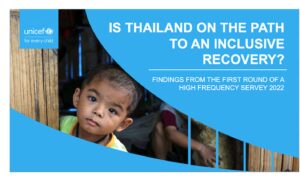Case Study: Assessing the Socio-economic Impact and Recovery from COVID-19 Across Thailand
UNICEF uses GeoPoll CATI surveys to conduct a multi-round assessment of the social and economic welfare of households in Thailand post-pandemic
Background
The lifting of COVID-19 restrictions in Thailand has resulted in a significant economic recovery, with growth in the third quarter of 2022 expanding to a year-high 4.5%. The recovery has not been experienced equally, however. Poverty rates, which had increased during the pandemic, have not returned to pre-pandemic levels.
Knowing that different groups in Thailand have experienced both the pandemic and the recovery differently, UNICEF desires to better understand the impacts that COVID-19 has had on households and on children in particular. To do so, UNICEF has enlisted GeoPoll to conduct a multi-round study to assess the social and economic welfare of households across the country.
Methodology
UNICEF’s High-Frequency Survey is comprised of two rounds of Computer Assisted Telephone Interviews (CATI) aimed at measuring the impacts of the COVID-19 pandemic and resulting restrictions on households and children. It also assesses the ongoing recovery from the pandemic and the impact of inflation. The study was designed to complement previous investigations, such as the World Bank’s Q2 2021 survey as well as the upcoming national MICS-2022 and Disability Surveys. The first round of UNICEF’s High-Frequency Survey was undertaken from August 5th to September 14th, and the second round is scheduled to take place in the first quarter of 2023.
The first round of the High-Frequency Survey resulted in 2,583 total interviews of adults over the age of 18 whose households were representative at the national level by household composition – as measured by the household having either at least one child ages 0-6, at least one child ages 7-17, at least one child in both age ranges, or no children. The respondents were reached by trained GeoPoll operators using verified randomized digit dialing (RDD), and all consented to being recontacted in 2023 to take the second-round interview.
The survey was comprised of the following modules designed to measure the impact of the pandemic across both social and economic dimensions:
- Employment
- Childcare
- Income
- Inflation
- Coping Strategies
- Food Security
- Social Assistance
- Education/Early Childhood Development
- Health and Vaccination
Results
Results from the study show that certain segments of the population experienced both the pandemic and the recovery differently. Households with children and households in the poorest and second poorest wealth index quintiles found it more difficult to resume working again after losing jobs or businesses. Over 60% of households in total indicated that they had experienced a reduction of income compared to the previous year, and households with both farm and non-farm businesses largely saw the incomes from these businesses decrease.
Of the respondents who had not worked in the week prior to the interview, the largest portion (24%) were not working due to obligations of childcare or caring for sick relatives. Rural households were more likely to miss work due to caring for children at 23% compared to 10% of urban households interviewed. These same inequalities in care obligations were observed across gender, with women more likely to miss work (19%) than men (8%).
Wealth also had an impact. The poorest and second poorest quintiles saw increased shares of respondents missing work to care for children with 17% and 20% respectively. Surprisingly, however, 24% of respondents in the richest quintile also missed work due to caring for children; possibly because they had the economic freedom to do so out of preference.
The study found that women overwhelmingly shouldered the burden of providing unpaid childcare, with mothers (48%) and grandmothers (29%) being the most likely to provide care when schools were closed due to COVID-19. Fortunately, a large majority of children in total (94%) returned to school when the schools reopened, though those in the poorest households and those in Northeastern Thailand saw lower return rates (81% and 83% respectively). Despite these trends, the study found that many obstacles still stand in the way of children receiving education, as fear of COVID-19 and perceptions of the poor effectiveness of remote learning continue to concern parents.
The full results from the first round of the survey can be found on UNICEF’s website:
https://www.unicef.org/thailand/reports/high-frequency-survey-findings-first-round
